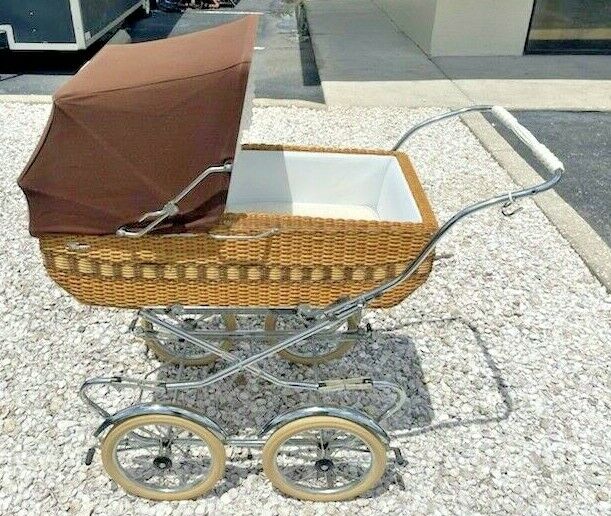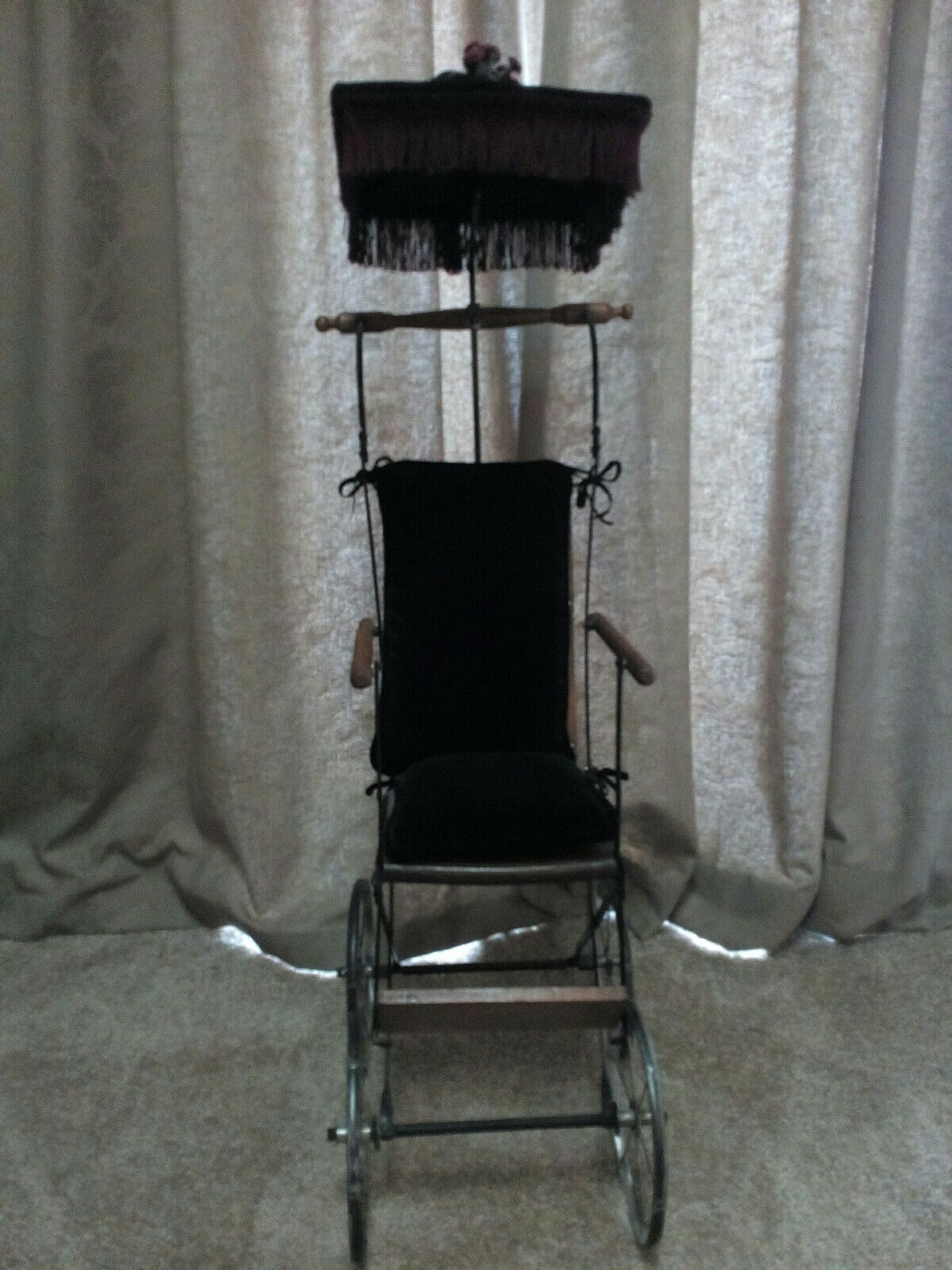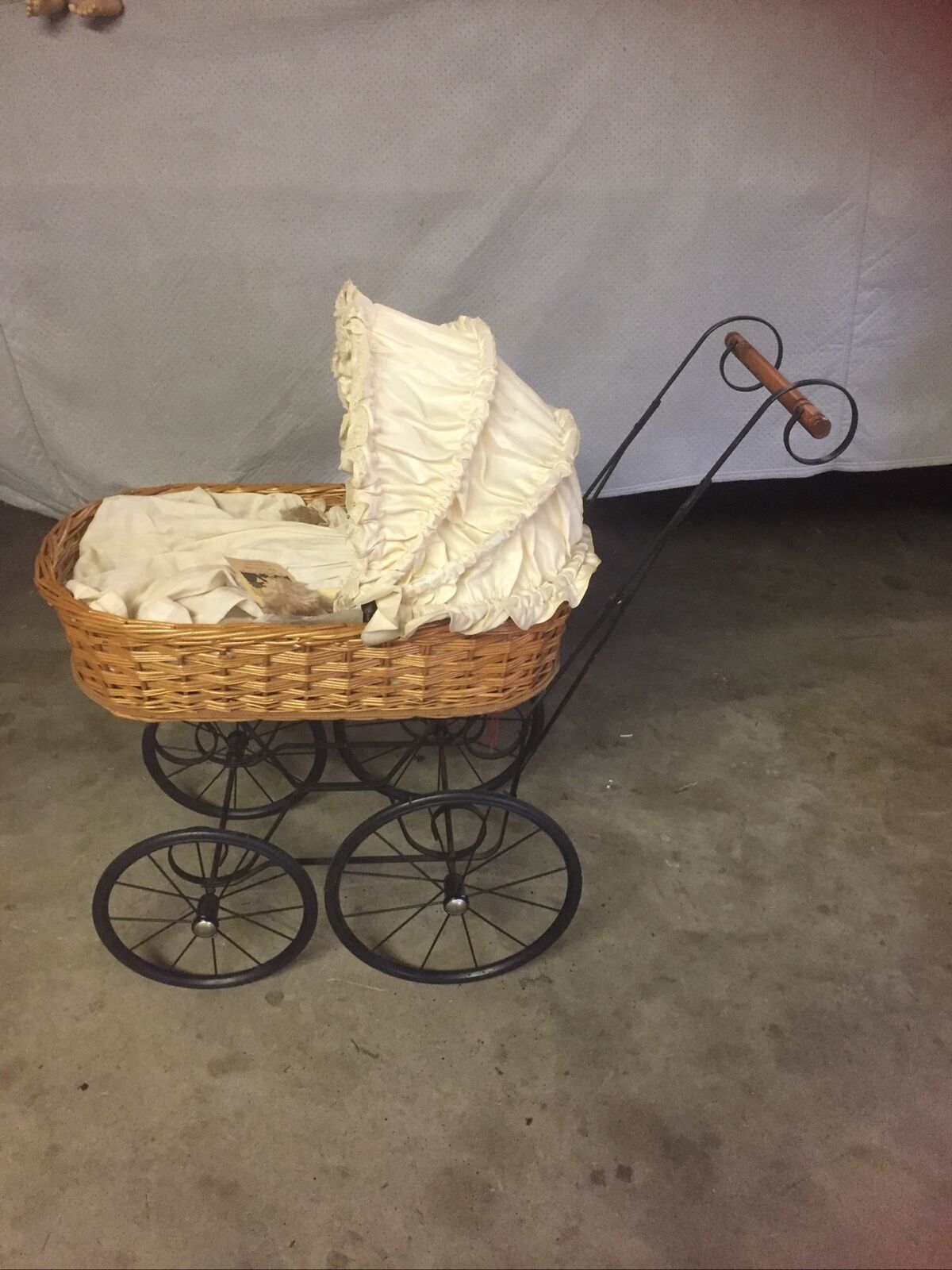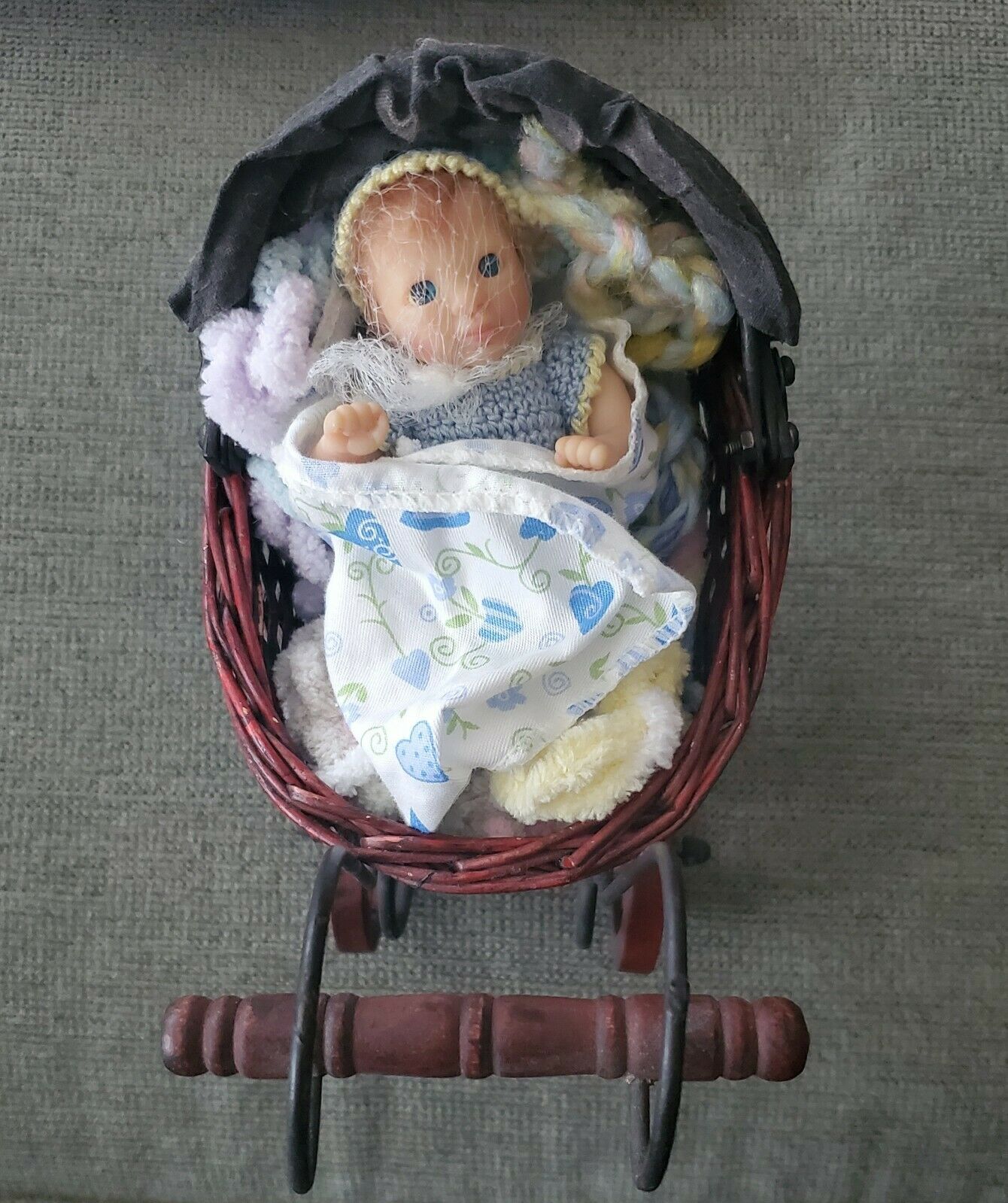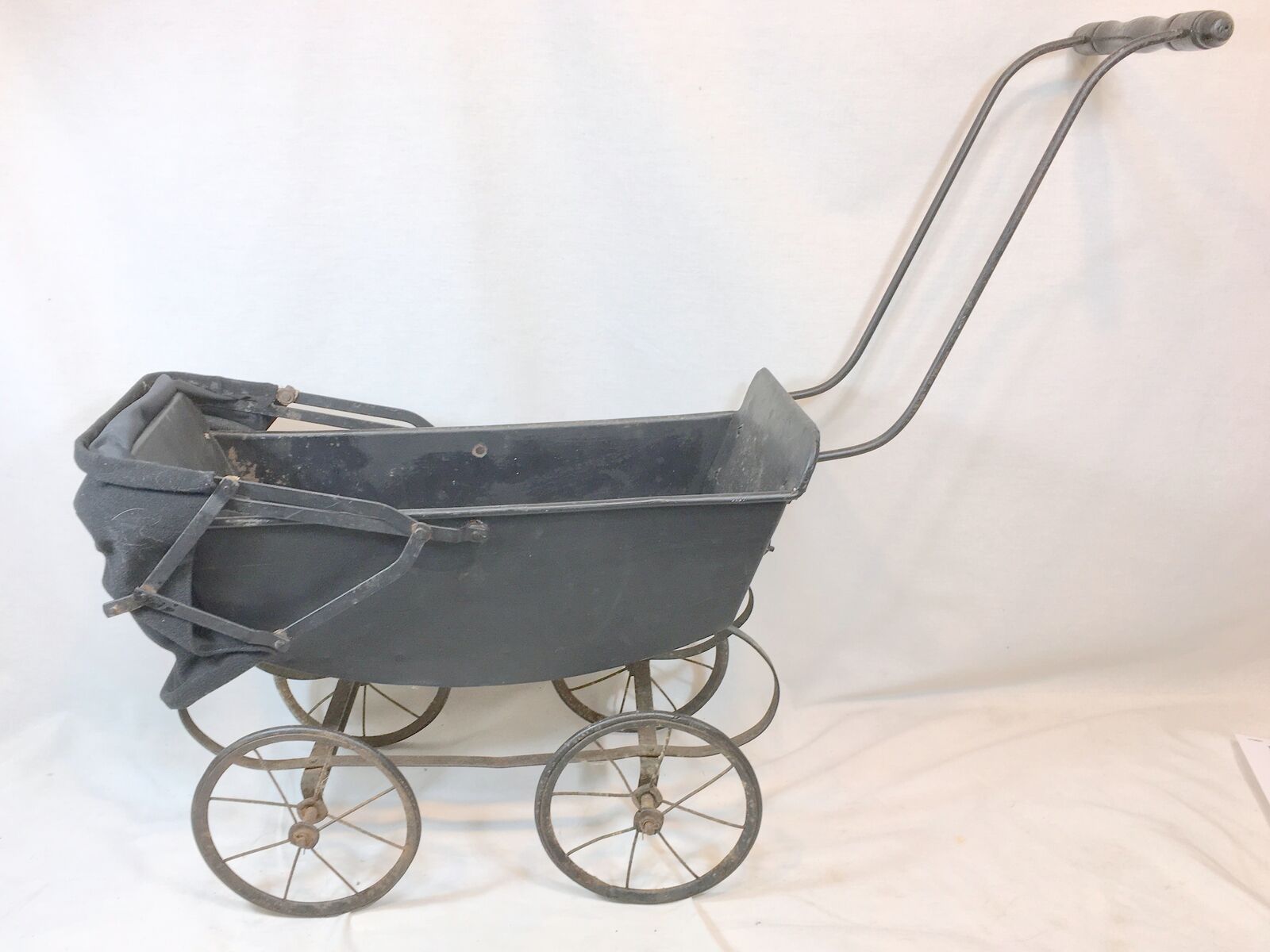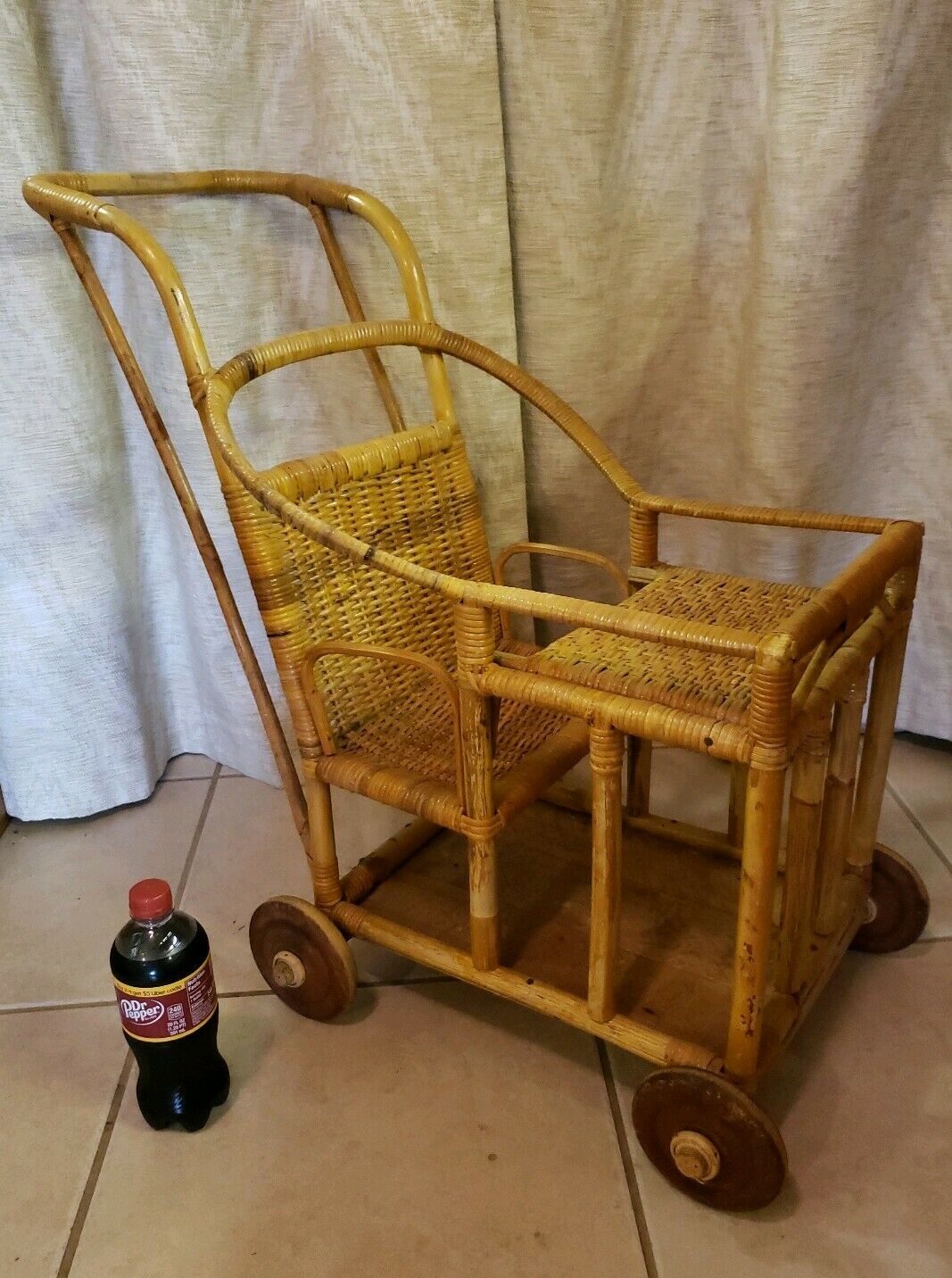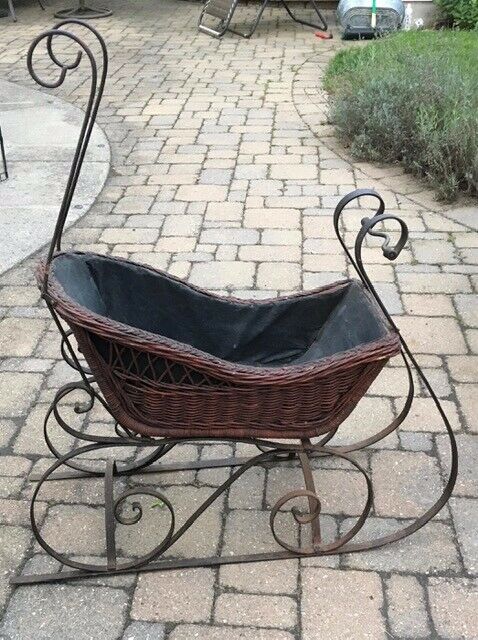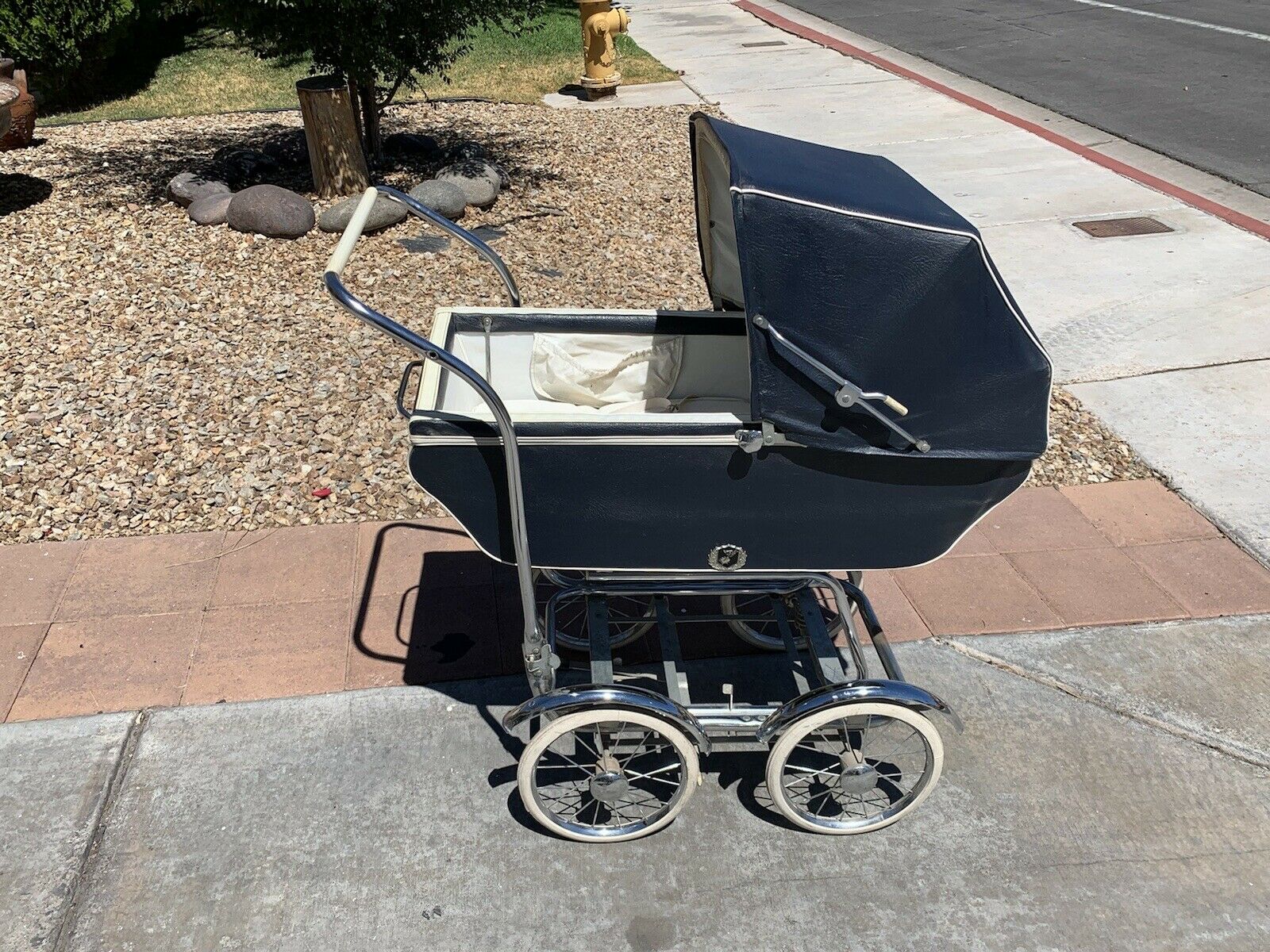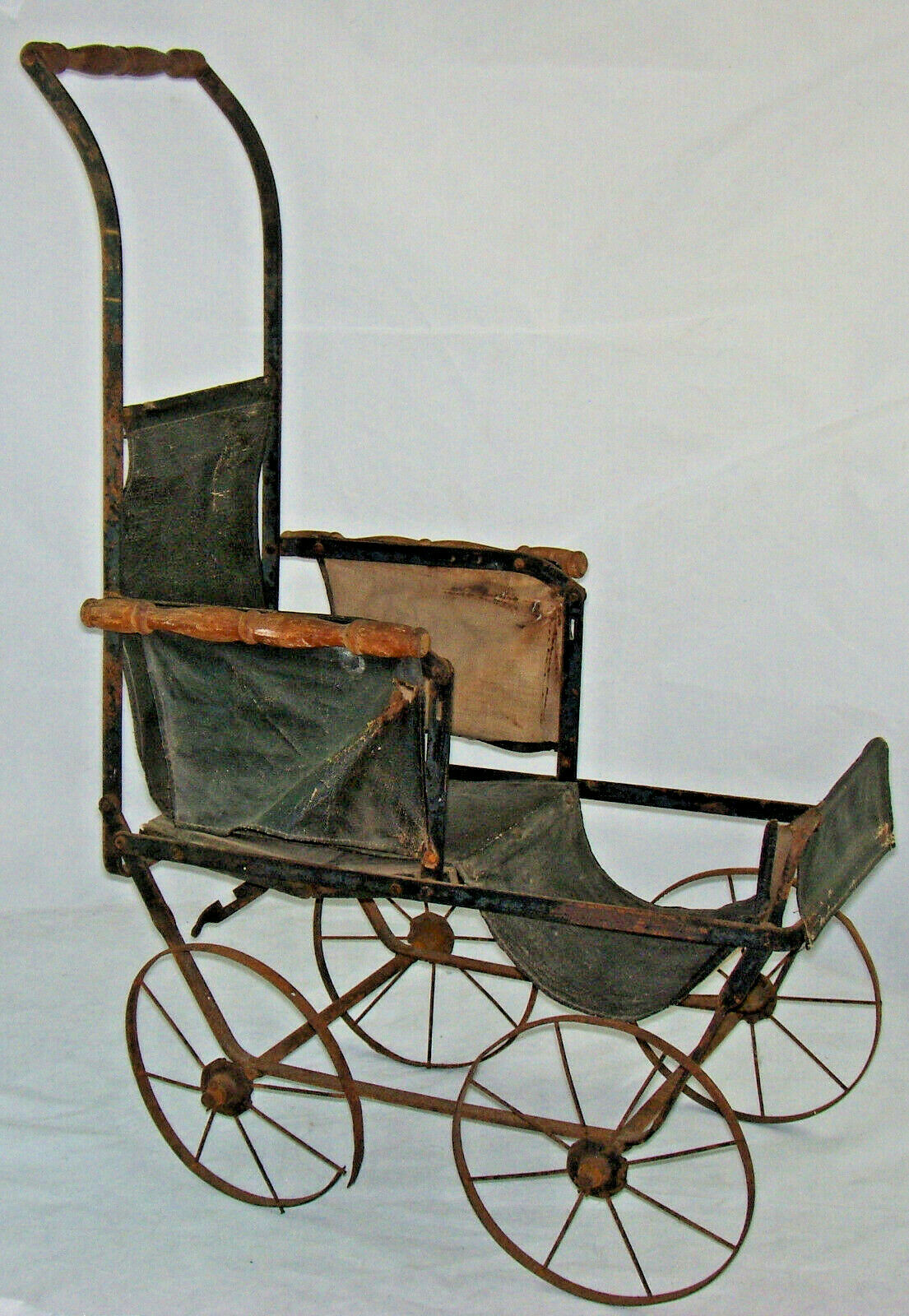-40%
Vintage Italian Peg Perego Pram Baby Carriage Arcore (Milano) Italy FLORIDA
$ 369.59
- Description
- Size Guide
Description
Vintage Italian Peg Perego Pram Baby Carriage - Arcore (Milano) ItalyComes as shown in and is fully functional. Their is very faint black marking which should come off however I don't want to touch it becuase sometimes it depreciates the value so its best just to leave it alone and let a professional do it in the last picture.
This is a classic Floridian Style Guiseppe Perego Italian Baby Carriage with Brown Hood & White Pad. The Bassinet piece can be detached and separated from the wheel base also. The Wheel compartment collapses for easy transport. The base detaches for use as a day bed or to use as a bassinet. Made in Italy, this Pram stroller is an amazing eye catcher, and super comfy baby stroller! The sun topper has a fabric sun shade which moves from the back to the front to protect the baby from the sun.
This Carriage Stroller is being sold "AS IS AS SHOWN" with NO RETURNS & NO WARRANTIES. ALL SALES ARE FINAL. LOCAL PICKUP is avilable or contact me for a USHIP Quote which is a white glove service from me to you but at the fraction of the cost to ship. Please contact me direct through messages or research our screename on google to call us if you have any more questions or need more pictures!
This item will be be shipped through USHIP directly from me to you unless your picking it up. Its a collectible and not covered by UPS or Fedex Insurance and we wouldnt take a risk of damaging this piece.
Below is the History if your interested in reading!
HISTORY
Peg Perego SpA
Arcore (Milano) Italy
Private Company
Incorporated: 1949
Employees: 1,500
Sales: EUR 200 (2 million) (2006 est.)
NAIC: 339932 Game, Toy, and Children’s Vehicle Manufacturing
Peg Perego SpA is one of the world’s best-known brands of high-end strollers, baby carriages, car seats, high chairs, and other baby care equipment and accessories, such as diaper bags and feeding accessories. The company, based in Arcore, Italy, is also the world’s leading manufacturer of children’s ride-on vehicles and other toys, including electric-powered and pedal-powered toys. Peg Perego’s line of strollers and baby equipment include the Primo Viaggio car seat line, the Pliko modular stroller systems, as well as double and even triple seat strollers, and traditional prams and baby carriages. The company was also a pioneer in the development of adjustable height high chairs, which remain an important part of the company’s product range. Other items produced by Peg Perego include walkers and jumpers.
While the company’s strollers and car seats and other baby care equipment and accessories target the newborn and toddler market, the company’s line of ride-on toys has enabled it to position itself in the older children’s segment as well. The company produces an industry-leading line of 6-volt, 12-volt, and chain-powered ride-on vehicles. Many of these vehicles are produced in partnership with such noted brands as John Deere, New Holland, Polaris, Ducati, Barbie, Antonio Carraro, and Jeep. There is even a ride-on train, complete with track, featuring the popular children’s television character Thomas the Tank Engine.
In addition to its ride-on toys, Peg Perego also produces a line of toy strollers, car seats, high chairs and related toys. Peg Perego supports its international sales with three factories in Italy, as well as factories in the United States, Canada, and Brazil. These operations combine to provide a total production surface of more than 160,000 square meters. Peg Perego remains a private company controlled by the Perego family. Brothers Gianluca and Lucio Clemente Perego, sons of the founder, share the chairmanship of the company.
BUILDING A BETTER STROLLER IN 1949
The Peg Perego company was born from a young father’s frustration. At the birth of his first child in 1949, Giuseppe Perego, of Arcore, Italy, sought a stroller in order to take his son on walks. At the time, strollers were hard to come by in the scarcity of postwar Italy, and the available prams and strollers were bulky, difficult to clean, and prone to rusting. Perego decided to fabricate a stroller based on his own design ideas. Perego built the frame, while his wife dressed the stroller in fabric. The resulting stroller quickly caught the attention of the Peregos’ neighbors, who asked the couple to build strollers for them as well. Before long the couple found themselves with a growing list of requests for strollers, and the Peregos made the decision to found a company to produce their stroller design. The Peregos called their company Peg Perego.
At the time of its founding, Peg Perego joined a market traditionally dominated by small workshops and craftsmen. Over the next decade, however, Peg Perego expanded its production from the workshop to the industrial level. The company sought a high degree of integration in its operations, and later came to control nearly the entire production process for their products. This commitment to integration enabled the company to establish itself as a leading innovator in the market for children’s equipment. For example, Peg Perego was the first to introduce easy-to-clean “rubberized” fabrics. The company also invested in its production technology, replacing the sheet metal and wicker of traditional carriage and stroller designs with injection-molded plastics. The use of new production techniques and materials allowed the company to continue to innovate in its product development, while also expanding its line. By the 1960s, Peg Perego had developed a range of stroller and carriage designs, including umbrella strollers. The company also began producing other baby care equipment and accessories, including high chairs, walkers and other items.
Peg Perego’s flair for design soon brought international interest for the company’s product line. At the same time, the extended baby boom, not only in Italy but also throughout much of the postwar Western world, had created a surge in demand for baby-related goods. The Peregos were quick to capitalize on the expanding demand, setting up an international distribution network. In this way, the company established itself as one of the leading brands in Europe and in North America. By the end of the twentieth century, Peg Perego had become one of the world’s top brands in baby strollers and related equipment.
RIDE-ON TO SUCCESS IN THE SIXTIES
Early on, Peg Perego recognized the importance of extending its product range beyond the infant and toddler set, capitalizing on its brand recognition to establish itself in the older children’s market. For this, the company saw an opportunity to build on its core expertise—wheeled vehicles—to roll out a line of ride-on toys. Starting in the early 1960s, Peg Perego soon revolutionized the ride-on toy market. Traditional ride-on toys had been made of metal, and were not only prone to rusting, but were also quite heavy and often difficult for children to pedal. By replacing the metal with injection-molded plastic, Peg Perego created a lighter-weight and more colorful vehicle that proved more durable. By the end of the decade, the company had also revolutionized the category, introducing its first battery-powered vehicles. The huge success of this category further reinforced the company as an international brand leader. Into the next decade, the company remained the world’s leading producer in the ride-on toy segment.
In the meantime, Peg Perego had developed another important product category, high chairs. For this, too, the company proved itself one of the market’s innovators. This was confirmed at the end of the decade, when the company launched the first adjustable high chair, allowing parents to raise and lower the infant’s seat. With the development of seat belt laws, and the recognition of the need for additional car safety protection for children in the 1970s, the company also extended its production to include its own line of car seats.
COMPANY PERSPECTIVES
Our continued growth and success is the result of a sustained commitment to designing and creating the most well-constructed and unique juvenile products and riding vehicles available today. Our philosophy remains as it was when Peg Perego started as a small one-man Italian business in the 1940s: a dedication to original and innovative products designed for discriminating consumers who demand fashion, individuality, quality and safety in the products they purchase for their babies and young children.
Peg Perego had by then established itself as an international manufacturer. The move into ride-on vehicles provided the company with an entry into the North American market in the early 1960s, and by 1966 the company had opened a production facility in Don Mills, Ontario. That operation began with the production of pedal cars, and by 1967 had begun to manufacture Peg Perego’s line of strollers and carriages as well. The Canadian subsidiary later developed something of a specialty in the chain-driven market, becoming the supplier of these systems to the company’s U.S. production and distribution subsidiary, located in Fort Wayne, Indiana.
This led to a significant expansion of the Canadian production facility, which moved to Pickering, in Ontario, in 1980. From an initial 30,000 square feet of production space, an addition to that plant doubled it in size in 1987. By the late 1990s, the Canadian subsidiary’s operations had been expanded with an assembly facility as well, boosting its total square footage beyond 100,000 square feet. In the meantime, the rising economies in the South American market permitted Peg Perego to expand its operations there as well, with the establishment of a Brazilian subsidiary.
Giuseppe Perego had been joined in the business by sons Gianluca and Lucio Clemente Perego, who took over as heads of the company upon their father’s death in 1984. The Perego brothers were committed to maintaining Peg Perego’s status as a family-owned company. They were also committed to retaining Peg Perego’s position at the leading edge of the increasingly competitive market for baby equipment. The company targeted the higher end of the market, reinforcing its image by maintaining a limited and exclusive distribution network.
INNOVATION LEADER FOR THE NEW CENTURY
In this way, Perego was able to maintain its position at the top of a market that had attracted an increasing number of competitors. Indeed, as the baby boomer generation themselves became parents, the market for infant equipment continued to expand. At the same time, the rise of a new, highly affluent, brand-driven social class had created a surge in demand for strollers and baby carriages with price tags of ,000 and even more. Although at times overshadowed by the latest hot name in the segment, Peg Perego’s more than 50 years of experience enabled it to resist the competition and maintain its place as a major name in the market. Nonetheless, the company took steps to expand its own brand portfolio, acquiring high-end Italian stroller manufacturer Martinelli, a company founded in the 1930s.
The willingness of many consumers to lavish generous amounts of money on their children helped to grow the company’s ride-on toy line. With prices ranging as high as 0 or more for these products, Peg Perego grew strongly through the 1990s and into the 2000s. Perego also caught the spirit of the times by developing a strong licensing program, producing vehicles under license for a variety of brands, including John Deere, New Holland, Polaris, Ducati, Barbie, Antonio Carraro, Jeep, and Thomas the Tank Engine. For the latter, the company developed a ride-on train complete with its own track.
Not all of the company’s product rollouts met with full-scale success, however. In the late 1990s, the company was forced to recall some 274,000 of its battery-powered ride-on toys because of issues with overheating batteries and sticking accelerator pedals. In one instance, a child suffered second-degree burns, while in another, a child suffered a concussion after an accelerator pedal failed to release. At the beginning of the 2000s, the company was forced to recall more than 325,000 high chairs. Such recalls proved relatively rare, however, in Peg Perego’s overall product history.
Peg Perego maintained a strong investment program in order to support the steady growth of both its infant equipment and ride-on toy operations. Into the middle of the first decade of the 2000s, the company’s extended production network included three facilities in Italy, as well as its Canadian, U.S., and Brazilian factories. The United States had by then developed into a major market for the company, and in 2004, the company launched a new .2 million investment program in order to expand its Fort Wayne operations with the construction of a new 125,000-square-foot warehouse and distribution center. Completed by 2006, the new facility helped expand Peg Perego’s total production and logistics operations to more than 1.2 million square feet.
KEY DATES
1949:
After building a stroller for their son, Giuseppe Perego and wife decide to found a company, Peg Perego, to produce strollers for others.
1961:
Peg Perego launches first ride-on vehicles for older children.
1966:
Entry into North American market with subsidiaries in Canada and the United States.
1984:
Giuseppe Perego dies and sons Gianluca and Lucio Clemente Perego take over as heads of company.
2001:
Peg Perego acquires Martinelli stroller company in Italy.
2007:
Launch of remote-controlled ride-on vehicles.
Peg Perego also showed no signs of relinquishing its role as an innovation leader in its core markets. The company continued to roll out innovative products, such as its own modular stroller system. In 2003, the company introduced its Dinamico, a “self-propelled” stroller. The company also introduced a battery-powered rocking chair. By 2007, the company had introduced a remote-control system for parents to use in conjunction with their children’s ride-on vehicles. As it approached its 60th anniversary, Peg Perego remained one of the best-known names among parents worldwide.
PRINCIPAL SUBSIDIARIES
Peg Perego Canada Inc.; Peg Perego USA Inc.
PRINCIPAL COMPETITORS
Mattel Inc.; Sega Sammy Holdings Inc.; Nintendo Company Ltd.; Namco Bandai Holdings Inc.; Hasbro Inc.; Tomy Company Ltd.; LEGO Group A/S; Little Tikes; Smoby S.A.; Playmobil Malta Ltd.; Milton Bradley Company; Jumbo S.A.; BRIO AB.
FURTHER READING
LeDuc, Doug, “Children’s Product Company to Build New Facility in Fort Wayne, Ind.,” News Sentinel, January 9, 2004.
_____, “Fort Wayne, Ind.-based Kiddie Car Maker to Extend New Toy Line,” News Sentinel, March 4, 2002.
“Peg Perego Introduces Self-Propelled Stroller,” Home Textiles Today, October 20, 2003, p. S24.
“Peg Perego Issues High Chair Recalls,” Home Accents Today, October 2001, p. S76.
Scahffel, Vivian Manning, “Pet Perego Strolls,” Brandchannel.com, February 16, 2004.
